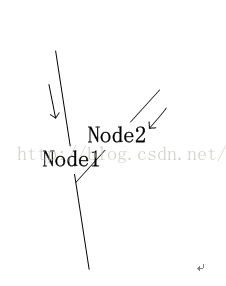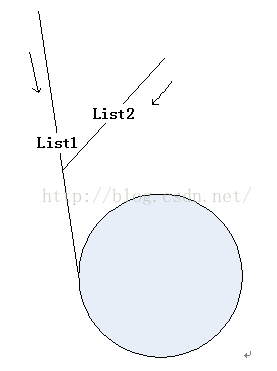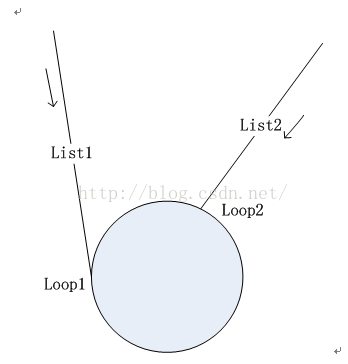题目
单链表可能有环,也可能无环。给定两个单链表的头节点 head1 和 head2, 这两个链表可能相交,也可能不相交。请实现一个函数,如果两个链表相交,请返回相交的第一个节点;如果不相交,返回 null 即可。
思考
链表分有环链表和无环链表,如果两个链表存在相交,则只有两种可能,两个链表都无环或者都有环。
- 如果链表都无环,则先判断链表的尾指针是否一样,如果不一样,则没有相交。如果一样,则找出两个链表的长度差,将两个链表从距离尾节点同样的距离进行扫描,如果相交,则必然有一处扫描节点相同。实例数据List1:1->2->3->4->5->6->7->null,List2:0->9->8->6->7->null,第一个相交节点为6
示例图如下,
2. 如果链表都有环,则只肯能有下面两种情况(如下图)。两种情况区分的方法为:入环点是否相同。
如果相同则为第一种情况:那么查找第一个相交点与无环的单链表相交找第一个交点的方法一样。
如果入环点不同,则为第二种情况,这个相交点或者为list1 的入环点loop1或者为list2的入环点loop2。
情况1实例数据(List1:1->2->3->4->5->6->7->4,List2:0->9->8->2->3->4->5->6->7->4,第一个交点为2)
情况2实例数据(List1:1->2->3->4->5->6->7->4,List2:0->9->8->6->7->4->5->6,第一个交点为4或6)
源码
public class FindIntersect {
public static class Node {
public int value;
public Node next;
public Node(int data) {
this.value = data;
}
}
/*判断是否相交,如果相交,得到第一个相交点*/
public static Node getIntersectNode(Node head1, Node head2) {
if (head1 == null || head2 == null) {
return null;
}
Node loop1 = getLoopNode(head1);
Node loop2 = getLoopNode(head2);
if (loop1 == null && loop2 == null) {
return noLoop(head1, head2);
}
if (loop1 != null && loop2 != null) {
return bothLoop(head1, loop1, head2, loop2);
}
return null;
}
/*
* 判断是否存在环,如果存在,则找出环的入口点。
* 入口点找法:快慢指针,块指针走两步,满指针走一步,如果存在循环,则在慢指针走完环前,总会和快指针相遇。
* 从头指针和相遇点同时向后走,相遇的点必定是入口点。(下面数学推导)*/
public static Node getLoopNode(Node head) {
if (head == null || head.next == null || head.next.next == null) {
return null;
}
Node n1 = head.next; // n1 -> slow
Node n2 = head.next.next; // n2 -> fast
while (n1 != n2) {
if (n2.next == null || n2.next.next == null) {
return null;
}
n2 = n2.next.next;
n1 = n1.next;
}
n2 = head; // n2 -> walk again from head
while (n1 != n2) {
n1 = n1.next;
n2 = n2.next;
}
return n1;
}
/*无环时的判断方法*/
public static Node noLoop(Node head1, Node head2) {
if (head1 == null || head2 == null) {
return null;
}
Node cur1 = head1;
Node cur2 = head2;
int n = 0;
while (cur1.next != null) {
n++;
cur1 = cur1.next;
}
while (cur2.next != null) {
n--;
cur2 = cur2.next;
}
if (cur1 != cur2) {
return null;
}
cur1 = n > 0 ? head1 : head2;
cur2 = cur1 == head1 ? head2 : head1;
n = Math.abs(n);
while (n != 0) {
n--;
cur1 = cur1.next;
}
while (cur1 != cur2) {
cur1 = cur1.next;
cur2 = cur2.next;
}
return cur1;
}
/*有环时的判断方法*/
public static Node bothLoop(Node head1, Node loop1, Node head2, Node loop2) {
Node cur1 = null;
Node cur2 = null;
if (loop1 == loop2) {
cur1 = head1;
cur2 = head2;
int n = 0;
while (cur1 != loop1) {
n++;
cur1 = cur1.next;
}
while (cur2 != loop2) {
n--;
cur2 = cur2.next;
}
cur1 = n > 0 ? head1 : head2;
cur2 = cur1 == head1 ? head2 : head1;
n = Math.abs(n);
while (n != 0) {
n--;
cur1 = cur1.next;
}
while (cur1 != cur2) {
cur1 = cur1.next;
cur2 = cur2.next;
}
return cur1;
} else {
cur1 = loop1.next;
while (cur1 != loop1) {
if (cur1 == loop2) {
return loop1;
}
cur1 = cur1.next;
}
return null;
}
}
public static void main(String args[]){
//侧重算法,没有实现链表部分
Node node1 = new Node(1);
Node node2 = new Node(2);
Node node3 = new Node(3);
Node node4 = new Node(4);
Node node5 = new Node(5);
Node node6 = new Node(6);
Node node7 = new Node(7);
node1.next = node2;
node2.next = node3;
node3.next = node4;
node4.next = node5;
node5.next = node6;
node6.next = node7;
node7.next = node4;
Node node11 = new Node(0);
Node node22 = new Node(9);
Node node33 = new Node(8);
node11.next = node22;
node22.next = node33;
node33.next = node6;
Node result = getIntersectNode(node1,node11);
System.out.print(result.value);
//输出4
}
}
环的入口
当fast与slow相遇时,slow肯定没有走遍历完链表,而fast已经在环内循环了n圈(1<=n)。假设slow走了s步,则fast走了2s步(fast步数还等于s 加上在环上多转的n圈),设环长为r,则:
2s = s + nr
s= nr
设整个链表长L,入口环与相遇点距离为x,起点到环入口点的距离为a。
a + x = nr
a + x = (n – 1)r +r = (n-1)r + L - a
a = (n-1)r + (L – a – x)
(L – a – x)为相遇点到环入口点的距离,由此可知,从链表头到环入口点等于(n-1)循环内环+相遇点到环入口点(从相遇点向后遍历循环回到入口点的距离),于是我们从链表头、与相遇点分别设一个指针,每次各走一步,两个指针必定相遇,且相遇点为环入口点,也即为两个链表的第一个相同节点。
参考:
http://blog.csdn.net/happymatilian/article/details/47811161
http://blog.csdn.net/linyunzju/article/details/7753548
http://blog.csdn.net/jiqiren007/article/details/6572685
http://blog.csdn.net/javaacmer/article/details/9004814

























 330
330

 被折叠的 条评论
为什么被折叠?
被折叠的 条评论
为什么被折叠?








